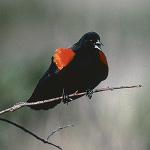The male Red-winged Blackbird is very handsome, with a solid black body and bright red patches on his wings. The female is streaky brown. She is seldom seen during nesting, because she stays hidden.
Fun Facts:
In winter, Red-winged Blackbirds join noisy foraging (hunting and feeding) flocks of 500 to over 5000 birds of several species: Brewer’s Blackbirds, Tricolor Blackbirds, Yellow-headed Blackbirds, European Starlings and Brown-headed Cowbirds.
The blackbird uses a method called “gaping” to find insects and seeds under the ground. It sticks its closed bill into the ground and then opens it. This makes a hole in the soil, exposing insects and seeds underground.
Life Cycle:
In the spring, males arrive at the nesting grounds. These nesting grounds are often in marshes or in fields near water. The males select an area for their nest. It is usually found in tall wetland plants such as cattails and tules. They sing loudly to claim their territory and to attract a female. In about a week, the females arrive and select the males that have claimed the best territory for nesting and feeding. The males defend their territory and aggressively drive away hawks and other intruders.
It takes 3 to 6 days for the male and female to build a nest of grass and reeds. The female lays 3 or 4 bluish eggs with dark spots. The eggs hatch after 10 to 12 days. The young can fly at 11 to 14 days old but they can swim at 5 to 6 days old. This is important because the nest is often near water.
Ecology:
The Red-winged Blackbird lives in or near wetlands full of cattails and tules. They also live near water in shrubby thickets of willow or blackberry. In vernal pool grasslands, you can find them near the deeper pools where Spikerush grows.
Red-winged Blackbirds forage (hunt) for food in open grasslands, wet meadows and agricultural cropland. In fall and winter they eat mostly seeds and the grain left in farmer’s fields, such as rice, oats and corn. During spring and summer, the birds need more protein to lay eggs and raise their young. To get the extra protein, they add spiders and bugs to their diet, including flies, mosquitoes and ground-dwelling insects.
Adult Red-winged Blackbirds are eaten by the Gopher Snake and other snakes. They are also eaten by the Red-tailed Hawk and other hawks. Predators of their eggs and young include snakes such as the California King Snake, raccoons, skunks, and other small mammals.
Conservation:
About 400 million Red-winged Blackbirds live in North America. Although this bird is common, its populations still suffer from habitat loss. As wetlands and upland foraging habitat disappear, there is less food and shelter for the Red-winged Blackbird. Less habitat means fewer birds.
Investigate:
When you visit wetlands or vernal pool grasslands, listen for the rusty squeak of the male Red-winged Blackbird. Watch his behavior. Where does he perch to sing? Does he look like he is trying to be noticed? Name one benefit of being noticed. What might be a disadvantage of being so obvious?
